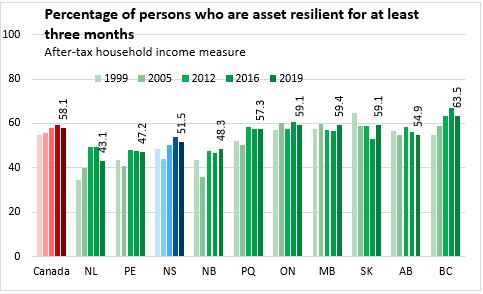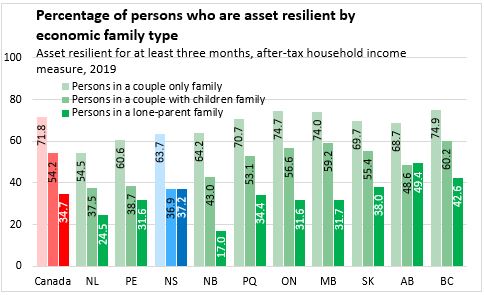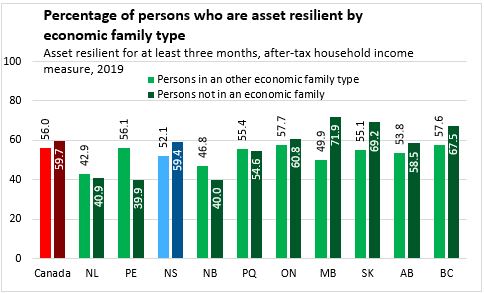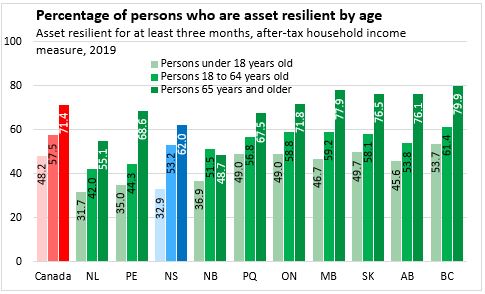The Economics and Statistics Division maintains archives of previous publications for accountability purposes, but makes no updates to keep these documents current with the latest data revisions from Statistics Canada. As a result, information in older documents may not be accurate. Please exercise caution when referring to older documents. For the latest information and historical data, please contact the individual listed to the right.
<--- Return to Archive
For additional information relating to this article, please contact:
May 11, 2021ASSET RESILIENCE, 2019 Statistics Canada recently published an article describing the asset resilience of Canadians. This indicator reflects the proportion of people living in households that hold sufficient liquid assets to maintain a level of income, in the face of a sudden and unexpected loss of their primary source of income or other financial shocks as a result of unplanned life events. In the analysis below, a household is asset resilient when it has at least enough liquid assets to cover their after-tax income for three months.
In 2019, 51.5% of persons were asset resilient in Nova Scotia. This was lower than the national average of 58.1%. Across the country, British Columbians were the most asset resilient (63.5%) while those in Newfoundland and Labrador were the least (43.1%).
Over time, households have generally become more asset resilient. All provinces reported higher asset resilience in 2019 compared to 1999 except for Saskatchewan and Alberta. Asset resilience rose for several reasons, including increased holdings of liquid assets, rising family incomes, and a higher median age.

Couple families without children were the most asset resilient among family types, with 63.7% of Nova Scotian couples without children having enough liquid assets to cover their financial obligations for three months. Nationally, 71.8% of couples were asset resilient. British Columbian (74.9%) households were the most asset resilient while those in Newfoundland and Labrador (54.5%) were the least in 2019.
In 2019, 36.9% of couple families with children were asset resilient in Nova Scotia. This was the lowest among the provinces, while British Columbia was the highest (60.2%). Nationally, 54.2% of couples with children were asset resilient in 2019.
In 2019, 37.2% of lone parent Nova Scotians were asset resilient, compared to 34.7% nationally. New Brunswick lone parents were the least asset resilient at 17.0% in 2019. Alberta reported 49.4% of lone parent families were asset resilient in 2019.

Among persons not in an economic family (including people living alone or living with people with whom they are not related), 59.4% were asset resilient in Nova Scotia in 2019. This is only slightly lower than the national average of 59.7% in 2019. Prince Edward Island (39.9%) and New Brunswick (40.0%) reported the lowest rate of asset resilience among those not in economic families, while Manitoba reported the highest at 71.9%.
Among those in other economic family types (including co-resident siblings, grandchildren living with grandparents, etc.) 52.1% were considered asset resilient in Nova Scotia in 2019, compared to 56.0% nationally.

Those under the age of 18 are the least likely to be asset resilient. In 2019, 32.9% of Nova Scotians were asset resilient compared to 48.2% nationally. The lowest asset resilience was in Newfoundland and Labrador (31.7%) while the highest was in British Columbia (53.7%) among those aged 18 and under.
Among those aged 18 to 64, 53.2% Nova Scotians were asset resilient in 2019. In the same year, 57.5% of Canadians were asset resilient, with the highest proportion of persons reported in British Columbia (61.4%) and the lowest in Newfoundland and Labrador (42.0%).
For those aged 65 and over in Nova Scotia, 62.0% were asset resilient compared to 71.4% nationally. The highest rate of asset resilience among those aged 65 and over was in British Columbia (79.9%) while the lowest was in New Brunswick (48.7%).

Source: Statistics Canada. Table 11-10-0083-01 Percentage of persons who are asset resilient, Canada and provinces
<--- Return to Archive